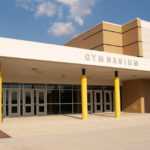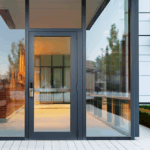Prior to the 2009 edition of the International Building Code and NFPA 101 – The Life Safety Code, health care facilities with a need to contain patients for their safety did not have a lot of options. Although there was some leeway with locking requirements for psychiatric facilities, other types of health care units, such as memory care, maternity, pediatrics, and emergency rooms were not specifically addressed. For these areas, delayed egress locks or alarms could be installed, but they weren’t always enough to deter patients or visitors from using the doors. This put the patients at risk of elopement, or in the case of infants and children – possible abduction.
The 2009 edition of the IBC added a section called Special Locking Arrangements in Group I-2 (1008.1.9.6), which described a fail-safe lock that would be released in an emergency, but the code section used the terminology “delayed egress lock” even though the code did not require the product that is commonly known by that name in the door and hardware / security industry. The 2012 edition of the IBC corrected the terminology by changing “delayed egress lock” to “special egress lock” (1008.1.9.6). In the 2015 edition of the IBC, the terminology was changed again (hopefully for the last time) to “controlled egress lock” (1010.1.9.6), and the section was expanded to apply to Group I-1 as well as Group I-2.
These changes explain why there is some confusion surrounding delayed egress vs. controlled egress. While a controlled egress device allows the egress doors serving certain areas to remain locked until they are unlocked by staff, the automatic fire protection system, or a power failure, delayed egress locks must automatically unlock 15 seconds after a building occupant actuates the device by pressing on the touchpad or the door, along with other emergency egress requirements. The section of the IBC addressing controlled egress in certain areas of a health care facility does not require the door to unlock automatically after 15 seconds.
The IBC does not specifically address which types of health care units can be equipped with controlled egress locks, but the 2015 IBC Commentary states: “The areas where controlled egress may be permitted include psychiatric areas, dementia units, Alzheimer’s units, maternity units, and newborn nurseries. Code officials may also permit these provisions in other areas such as emergency departments or pediatric areas where the safety and/or security of the occupants are of primary concern.” This helps to establish the intent of section 1010.1.9.6.
This table compares the IBC requirements for both types of systems. Let me know if I forgot anything!
| Delayed Egress | Controlled Egress | |
| 2015 IBC Code Section | 1010.1.9.7 – Delayed Egress | 1010.1.9.6 Controlled egress doors in Groups I-1 and I-2 |
| Use Groups Where Allowed | Any Use Group except Assembly, Educational, or High Hazard | Only in Use Groups I-1 (alcohol and drug centers, assisted living facilities, congregate care facilities, group homes, halfway houses, residential board and care facilities, social rehabilitation facilities) and I-2 (foster care facilities, detoxification facilities, hospitals, nursing homes, psychiatric hospitals) – where the clinical needs of persons receiving care require their containment. Prior to the 2015 edition, this section was limited to Use Group I-2. |
| Required Fire Protection System | Equipped throughout with an automatic sprinkler system or approved automatic smoke or heat detection system. | Equipped throughout with an automatic sprinkler system or approved automatic smoke or heat detection system. |
| Actuation Time | Up to 3 seconds (was 1 second prior to the 2015 IBC) when force of 15 pounds is applied. | Release is not required to be actuated by an occupant attempting to operate the door. |
| Automatic Release Delay | 15-second delay before lock releases to allow egress (30 seconds with AHJ approval). | Lock is not required to release automatically after actuating the door hardware. |
| Rearming After Actuation | Manual rearm required. | Not addressed in the 2015 IBC. |
| Audible Alarm | Audible alarm required. | No audible alarm required. |
| Signage | Required Signage: “Push [pull] until alarm sounds. Door can be opened in 15 [30] seconds.” Signage must be on the door within 12 inches of the door exit hardware. New in 2015: Signage must comply with A117.1 requirements. In Group I occupancies, AHJ may allow signage to be omitted for certain types of treatment areas. | No signage required. |
| Action on Actuation of Fire Alarm / Sprinkler System |
Unlock for immediate egress (no delay). | Unlock for immediate egress (not required for psychiatric treatment areas, and – new in 2015 – not required when a listed child abduction system is used in an I-2 hospital nursery or obstetric area). |
| Action on Power Failure | Unlock for immediate egress (no delay). | Unlock for immediate egress (not required for psychiatric treatment areas, and – new in 2015 – not required when a listed child abduction system is used in an I-2 hospital nursery or obstetric area). |
| Remote Release | Capable of being deactivated at the fire command center and other approved locations. | Capable of being unlocked by a switch which directly breaks power to the lock, located at the fire command center, nursing station, or other approved location (not required for psychiatric treatment areas, and – new in 2015 – not required when a listed child abduction system is used in an I-2 hospital nursery or obstetric area). |
| Staff Release | Not required. | Procedures for unlocking doors must be part of emergency plan. All clinical staff must carry keys, codes, or other credentials to unlock doors. |
| Emergency Lighting | Required on the egress side of the door. | Must be provided at the door. |
| Maximum Quantity of Locks per Egress Path | One delayed egress lock per egress path. New in 2015: I-2 or I-3 occupancies may have 2 doors with delayed egress locks in one egress path, with a maximum combined delay of 30 seconds. | Occupant must not be required to pass through more than one controlled egress lock before entering an exit (not limited in psychiatric treatment areas, and – new in 2015 – not limited when a listed child abduction system is used in an I-2 hospital nursery or obstetric area) |
| Required Listings for Locking System | UL 294 – Standard for Access Control System Units | UL 294 – Standard for Access Control System Units |
| Type of Locking Hardware Used | Delayed egress panic hardware (for example, Von Duprin Chexit with 15-second delay), delayed egress mag-lock, or other electrified lock with listed delayed egress controller. | Controlled egress panic hardware (for example, Von Duprin Chexit with infinite release delay), electromagnetic lock, or other fail safe electrified lock. |
.
You need to login or register to bookmark/favorite this content.





So how do we address the special needs classroom(not sure this is the correct term. There is a teacher in the room but they can’t watch everyone every moment. But these are still in E occupancy – on I. Comply with the I rules and ask for the AHJ to rule?
Hi Jack –
The Builders Hardware Manufacturers Association (BHMA) submitted a code change proposal for the 2018 IBC, which would allow delayed egress (not controlled egress) to be used in schools. The original proposal limited the occupant load to 10 to try to address special needs classrooms which are typically smaller classes. I was not a fan of the 10-person limit, only because if the occupant load is calculated rather than actual, a 10-person classroom is 200 square feet so virtually every classroom would be over the occupant load of 10. The ICC technical committee supported the proposal, but without the 10-person limit, so it’s possible that delayed egress will be allowed in Educational occupancies in the 2018 IBC. NFPA 101 already permits delayed egress locks in schools. Delayed egress locks may not solve the problem of kids attempting to leave some of the classrooms, but at least if delayed egress is allowed by code, you could appeal to the AHJ to allow a longer delay or possibly a code modification for a controlled egress lock.
– Lori
Lori. Have a number of questions
1.Does the 3 second actuation time need to be approved for the DE door (This is a very critical item worth keeping as it sends a signal to the would-be offender that the door will alarm)? A
2. Does the 3 seconds count toward the 15 second release time?
3. If you have two or more doors in the path of egress, can you slave one to another so the door at the bottom of the stairs releases at the same time as the second floor door (in theory then, you would not have two DE doors you would have to go through)?
4. The new code requires the device to be UL 294 Listed? Since the DE is basically an egress restricting device, are there other listings it should carry?
Hi Jim –
1. The 3-second actuation time is now allowed by the IBC and would not need to be approved (if you mean approved by the AHJ) if the 2015 IBC had been adopted in the project’s jurisdiction, or if NFPA 101 had been adopted. If an older edition of the IBC is being used, 1 second actuation is required.
2. The codes are not specific on this, so it’s up to the AHJ. I was recently told that the Von Duprin Chexit has a total release time of 15 seconds, including the 1-second, 2-second, or 3-second actuation time.
3. The codes are not specific on this either, but I have done this several times on projects with no objection from the AHJ. It depends on the AHJ’s understanding and comfort level with the system.
4. If the delayed egress lock is panic hardware, it will also have the UL 305 listing, and if it’s used on a fire door it will have a listing for use on a fire door assembly, but I did not find another UL listing specific to delayed egress when I checked the UL directory. This article: http://library.ul.com/wp-content/uploads/sites/40/2015/02/fsa_issue_3_2012.pdf references several UL categories (FWAX, FULA, and ALVY), but in each case either UL 305 or UL 294 is the standard used.
– Lori
Thank you. My husband who has dementia is in a Memory care/assisted living community with an electronic door requiring a key fob and a 15 second delay egress which bypasses the lock. Of course the residents, including my husband, figured out the delay trick quickly. They have requested that I look for another placement as he is too much trouble. The director claims both types of hardware are required according to the Fire Marshall. I question this and from reading the code, I think she is misinformed.
Hi Ann –
Controlled egress locks are allowed by current codes…my guess is that the local fire marshal would allow the change from delayed egress to controlled egress if he/she was informed about the code requirements. Controlled egress is a fairly recent addition to the codes, so not everyone is aware of that option.
Good luck, and let me know if you need more info.
– Lori
And I forgot to say…there’s also a video on my site about these applications: http://idighardware.com/2016/08/controlled-egress-vs-delayed-egress-video/.
– Lori
I have an autistic adult son that lacks hazard awareness and has poor impulse control in my private home in Los Angeles. Is a controlled egress permitted at the exit gate that would allow caregivers notice and time to supervise his exit into the community? Who can assist with design, approval and installation?
Hi Richard –
The codes for private homes don’t really address controlled egress but I can’t think of a reason it wouldn’t be allowed. I would contact a security integrator or a locksmith that deals with electrified hardware (not all locksmiths do). There are electromagnetic locks that are designed for exterior use, so that’s what I would ask about if you want to secure the gate and control egress. If you just want notification that someone is exiting, there are ways to do that as well. If you have trouble finding someone to help, let me know and I will ask our local office for a recommendation. You can email me at lori.greene@allegion.com.
– Lori